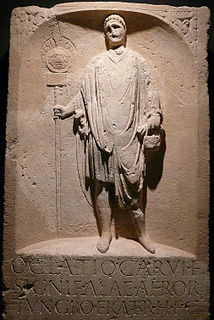 W
WAn aquilifer was a soldier signifer bearing the eagle standard of a Roman legion. The name derives from the type of standard, aquila meaning "eagle", and fers, related to the Latin word for bringing or carrying. Before that time, the wolf, boar, bull and horse were also used. The eagle standard was the most important possession of the legion, and its loss was a terrible disgrace.
 W
WA centurion was a position in the Roman army during Classical Antiquity, nominally the commander of a century, a military unit of around 80 legionaries. In a Roman legion, centuries were grouped into cohorts commanded by their senior-most centurion. The prestigious 1st cohort was led by the primus pilus, the most senior centurion in the legion and its third-in-command.
 W
WThe Comes tractus Argentoratensis was in late antiquity commander of units of the mobile field army of the Western Roman empire, operating along the Rhine frontier in the Diocese of Gaul.
 W
WThe draconarius was a type of signifer who bore a cavalry standard known as a draco in the Roman army.
 W
WDux is Latin for "leader" and later for duke and its variant forms.
 W
WThe imaginifer was one of the signiferi in a legion in the times of the Roman Empire, who carried the imago—the image—of the emperor.
 W
WThe Latin word imperator derives from the stem of the verb imperare, meaning 'to order, to command'. It was originally employed as a title roughly equivalent to commander under the Roman Republic. Later it became a part of the titulature of the Roman Emperors as part of their cognomen. The English word emperor derives from imperator via Old French: Empereür. The Roman emperors themselves generally based their authority on multiple titles and positions, rather than preferring any single title. Nevertheless, imperator was used relatively consistently as an element of a Roman ruler's title throughout the principate and the dominate. In Latin, the feminine form of imperator is imperatrix.
 W
WA legatus was a high-ranking Roman military officer in the Roman Army, equivalent to a modern high-ranking general officer. Initially used to delegate power, the term became formalised under Augustus as the officer in command of a legion.
 W
WA legatus Augusti pro praetore was the official title of the governor or general of some imperial provinces of the Roman Empire during the Principate era, normally the larger ones or those where legions were based. Provinces were denoted imperial if their governor was selected by the emperor, in contrast to senatorial provinces, whose governors were elected by the Roman Senate.
 W
WThe Roman legionary was a professional heavy infantryman of the Roman army after the Marian reforms. These soldiers would conquer and defend the territories of the Roman Empire during the late Republic and Principate eras, alongside auxiliary and cavalry detachments. At its height, Roman legionaries were viewed as the foremost fighting force in the Roman world, with commentators such as Vegetius praising their fighting effectiveness centuries after the classical Roman legionary disappeared.
 W
WThe megas doux was one of the highest positions in the hierarchy of the later Byzantine Empire, denoting the commander-in-chief of the Byzantine navy. It is sometimes also given in English by the half-Latinizations megaduke or megadux. The Greek word δούξ is the Hellenized form of the Latin term dux, meaning leader or commander.
 W
WAn optio, plural optiones and sometimes, albeit rarely, anglicised as option – was a position in a centuria (century) of a Roman army similar to that of an executive officer. The main function of an optio was as an optio centuriae, the second-in-command of a century, although there were many other roles an optio could adopt.
 W
WThe praefectus castrorum was, in the Roman army of the early Empire, the third most senior commander of the Roman legion after the legate (legatus) and the senior military tribune. His responsibility was looking after equipment and building works but he could command the legion when his seniors were absent. The post was usually held by men coming from the ranks of the centurionate, having already served as chief centurions of a legion, and was therefore open to ordinary citizens. A camp prefect's job was to maintain and update the equipment, organize the legion, and make sure that the soldiers were properly trained. Prefects of this rank, for example Sextus Vibius Gallus, were awarded prizes (dona) to mark their achievements.
 W
WA signifer was a standard bearer of the Roman legions. He carried a signum (standard) for a cohort or century. Each century had a signifer so there were 59 in a legion. Within each cohort, the first century's signifer would be the senior one.
 W
WThe signiferi of the Roman legions were the ranks entrusted with various tasks to do with standard-bearing. Early in the Roman Republic the single rank signifer performed all these tasks but later in the Empire the tasks became more specialist with different ranks created for specific tasks, including the aquilifer, imaginifer, and the draconarius.
 W
WThe tres militiae was a career progression of the Roman Imperial army for men of the equestrian order. It developed as an alternative to the cursus honorum of the senatorial order for enabling the social mobility of equestrians and identifying those with the aptitude for administration. The three posts, typically held over a period of two to four years, were prefect of a cohort, military tribune, and prefect of an ala (wing).
 W
WVexillarius is a term referring to one of several distinct types of Roman soldier.